Related Research Articles

Grevillea banksii, commonly known as Banks' grevillea, Byfield waratah, red flowered silky oak and dwarf silky oak, and in Hawaii as kāhili flower, is a species of flowering plant in the family Proteaceae and is endemic to Queensland. It is an erect shrub or slender tree with divided leaves with four to twelve narrow lobes, and creamy white to bright scarlet and yellow flowers.
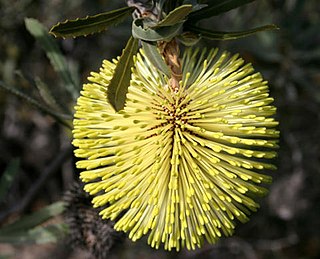
Banksia rosserae is a recently described species of Banksia. Endemic to inland Western Australia, it is the only Banksia species to occur solely within the arid zone.

Banksia tricuspis, commonly known as Lesueur banksia or pine banksia, is a plant in the family Proteaceae and is endemic to a small area in the south-west of Western Australia. It is a stunted tree or shrub with narrow leaves and cylindrical spikes of golden-coloured flowers and it occurs in a geographic range of just 15 square kilometres near Jurien.
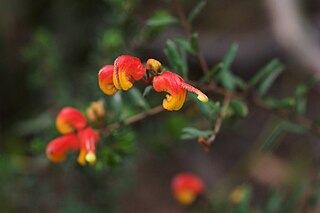
The Australian flowering shrub Grevillea alpina has several common names, including mountain grevillea, alpine grevillea, and cat's claws. It is not limited to alpine environments, and in fact is less common at high elevation than low. The species is variable in appearance, with five general forms described: small-flowered, Grampians, Northern Victorian, Goldfields, and Southern Hills forms. It is found in dry forests and woodlands across Victoria and into southern New South Wales. Some forms of the plant are low to the ground, and some become a spreading shrub. The flowers come in many colours, from white to green to shades of red and pink, or a pattern of several colours. The curled flowers are 1 to 3 centimetres in length. It is attractive to nectar-feeding insects and birds.
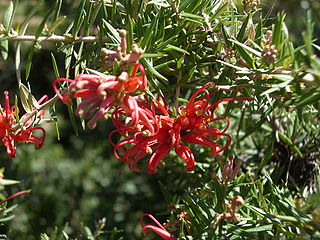
Grevillea juniperina, commonly known as juniper- or juniper-leaf grevillea or prickly spider-flower, is a plant of the family Proteaceae native to eastern New South Wales and southeastern Queensland in Australia. Scottish botanist Robert Brown described the species in 1810, and seven subspecies are recognised. One subspecies, G. j. juniperina, is restricted to Western Sydney and environs and is threatened by loss of habitat and housing development.
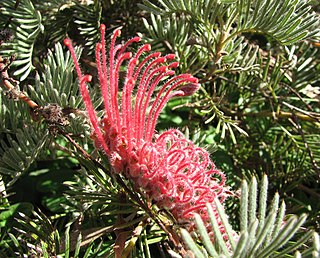
Grevillea thyrsoides is a species of flowering plant in the family Proteaceae, and is endemic to the southwest of Western Australia. It is a small, spreading or low-lying shrub, with pinnatisect to comb-like leaves, the end lobes linear, and clusters of hairy pinkish-red flowers.

Grevillea sericea, commonly known as the pink spider flower, is a species of flowering plant in the family Proteaceae and is endemic to New South Wales. It is a shrub with elliptic to lance-shaped leaves with the narrower end towards the base, and clusters of usually pink flowers arranged on one side of a flowering rachis.
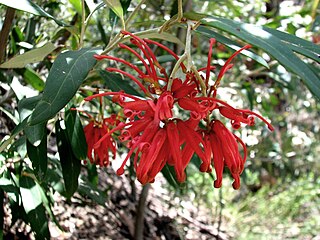
Grevillea victoriae, also known as royal grevillea or mountain grevillea, is a species of flowering plant in the family Proteaceae and is endemic to mountainous regions of south-eastern continental Australia. It is an erect to spreading shrub with elliptic to lance-shaped leaves, and pendulous clusters of red to orange flowers.

Grevillea venusta, commonly known as Byfield spider flower, is species of flowering plant in the family Proteaceae and is endemic to a small region of central eastern Queensland. It is an erect shrub with simple and/or divided leaves, the leaves or lobes narrowly oblong to narrowly elliptic, and clusters of green and yellow flowers with a deep maroon to purplish black style covered with white hairs.

Grevillea glossadenia is a species of flowering plant in the family Proteaceae and is endemic to Queensland, in northeastern Australia. It is an erect shrub with more or less elliptic leaves and deep yellow-orange to orange-red flowers.
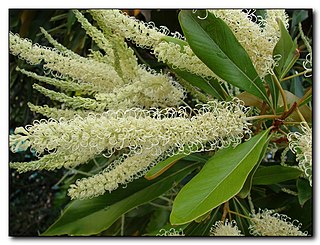
Grevillea edelfeltii, commonly known as white oak, is a tree of the family Proteaceae and is native to the rainforests of north-east Queensland in Australia and to Papua New Guinea.

Grevillea pteridifolia is a species of flowering plant in the family Proteaceae and is endemic to northern Australia. It is also known by many common names, including golden grevillea, silky grevillea, fern-leaved grevillea, golden parrot tree, golden tree, manbulu, yawuny and tjummula. It is a shrub or tree usually with pinnatisect leaves, and bright orange-yellow or reddish flowers.

Grevillea shiressii is a species of flowering plant in the family Proteaceae and is endemic to New South Wales where it is found in only two localities near Gosford. It is an erect shrub with oblong to narrowly lance-shaped and small clusters of green to bluish-grey, later cream-coloured flowers with a brownish-maroon style.
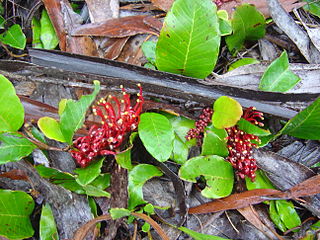
Grevillea laurifolia, commonly known as laurel-leaf grevillea, is a species of flowering plant in the family Proteaceae and is endemic to New South Wales. It is a prostrate, trailing shrub with egg-shaped, heart-shaped or round leaves, and clusters of reddish to deep maroon flowers.
William Lancashire Cane (1911–1987) was an Australian plantsman who introduced many new native plant species, forms and hybrids into cultivation.

Grevillea lanigera 'Mt Tamboritha' is a cultivar of the genus Grevillea, planted widely in Australia and other countries for its ornamental foliage and flowers. It is the most popular form of Grevillea lanigera in cultivation. It is also known by the names 'Mt Tamboritha form', 'Compacta', 'Prostrate', 'Prostrate Form' or the misnomer 'Mt Tambourine'.

Grevillea refracta, commonly known as silver-leaf grevillea, is a species of plant in the protea family and is native to northern Australia. It is a tree or shrub usually with pinnatipartite leaves and red and yellow flowers arranged on a branched, downcurved raceme.
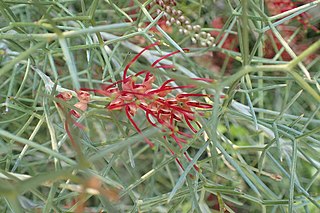
Grevillea squiresiae is a species of flowering plant in the family Proteaceae and is endemic to a small area in the Avon Wheatbelt region of Western Australia. It is a single-stemmed shrub, usually with pinnatipartite leaves, the end lobes more or less linear, and clusters of red flowers.

The Illawarra Grevillea Park is a botanical garden located in Bulli on the south coast of New South Wales, Australia.
References
- ↑ George, Alexander S; Gardner, Charles Austin (1996), The banksia book (3rd ed.), Kangaroo Press in association with the Society for Growing Australian Plants -N.S.W, ISBN 978-0-86417-818-3
- ↑ George, Alexander S; Gardner, C. A (1984), The Banksia book, Kangaroo Press in association with the Society for Growing Australian Plants, ISBN 978-0-86417-006-4
- ↑ George, Alexander S; Gardner, Charles Austin (1987), The banksia book (2nd ed.), Kangaroo Press in association with the Society for Growing Australian Plants N.S.W, ISBN 978-0-86417-143-6
- ↑ Olde, Peter; Marriott, Neil (1994), The Grevillea book, vol. 1, Kangaroo Press, ISBN 978-0-86417-325-6
- ↑ Olde, Peter; Marriott, Neil (1995), The Grevillea book, vol. 2 Species A-L, Kangaroo Press, ISBN 978-0-86417-326-3
- ↑ Olde, Peter; Marriott, Neil (1994), The Grevillea book, vol. 3 Species M-Z, Kangaroo Press, ISBN 978-0-86417-326-3
- ↑ Elliot, Winston Rodger; Jones, David Lloyd; Blake, Trevor L (1980), Encyclopaedia of Australian plants suitable for cultivation, Lothian Publishing Co. Pty. Ltd, ISBN 978-0-85091-070-4
- ↑ Fairley, Alan; Moore, Philip; Society for Growing Australian Plants (1989), Native plants of the Sydney district : an identification guide, Kangaroo Press in association with the Society for Growing Australian Plants-NSW, ISBN 978-0-86417-261-7
- ↑ Townsend, Keith (1997), Field guide to plants of the dry tropics, Society for Growing Australian Plants, Townsville Branch, ISBN 978-0-909830-54-0
- ↑ Townsend, Keith (1994), Across the top : gardening with Australian plants in the tropics, Society for Growing Australian Plants, Townsville Branch, ISBN 978-0-909830-46-5
- ↑ Bonney, Neville; Australian Plants Society (S.A.) (2004), Common native plants of the Coorong region : identification, propagation, historical uses, Australian Plants Society, South Australian Region, ISBN 978-0-646-44207-5
- ↑ Cavanagh, A. K., John Walter, and Jan Sked. (2007) Fifty years promoting Australian plants : a checklist of publications by SGAP and its members 1957–2007 Nedlands, W.A. : Association of Societies for Growing Australian Plants. ISBN 978-0-9587011-5-0
- ↑ Society for Growing Australian Plants (1959), Australian plants, Society for Growing Australian Plants, ISSN 0005-0008